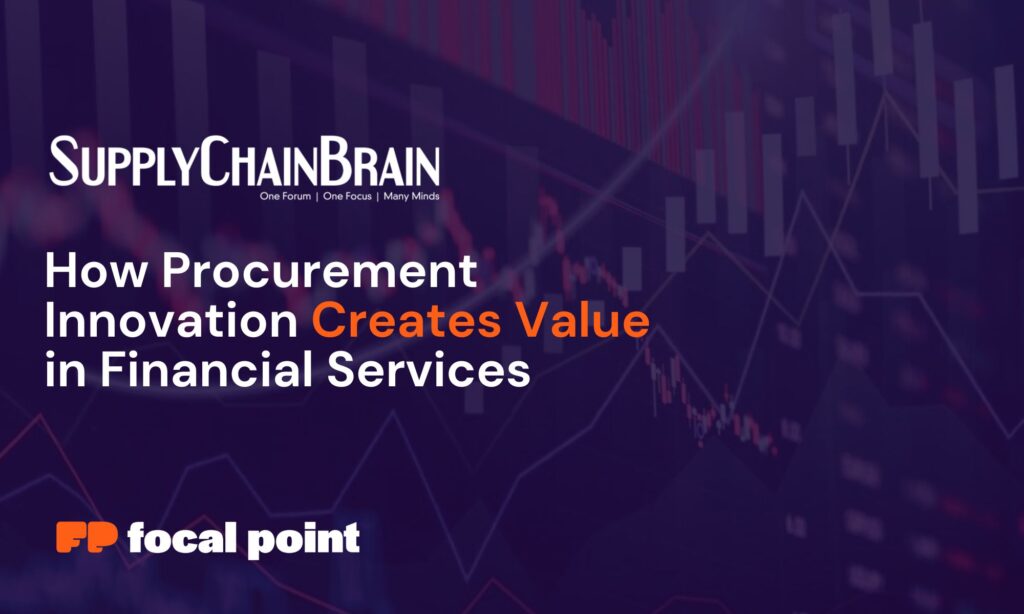By Alice Gumo, SCB Contributor
This article was originally published in SupplyChainBrain.
The past few years have demonstrated the procurement function’s ability to adapt to price fluctuations, changing consumer needs and supply chain disruptions. Once regarded as a back-office process, procurement is finally getting the respect it deserves, recognized for its contribution to the organization’s long-term, strategic agenda.
As Bain points out, this shift in mentality is now taking hold in the financial services industry. “Financial institutions have long been measured by three core indicators: growth, margin, and productivity,” the consultancy notes. “The power of procurement in contributing to the positive movement of these indicators is leading financial institutions to join a growing movement across sectors to rethink the role of the procurement function.”
From a maturity standpoint, the financial services sector has been at the vanguard of the procurement space for years. Third-party management was born out of increased scrutiny and risk assessment across the supply chain, and post-Great Recession financial institutions were early adopters of practices such as e-invoicing, integrated supplier management, and procure to pay (P2P) — the requisitioning, purchasing, receiving and accounting of goods and services.
However, financial services is also an industry of contradictions, often siloed within individual business units. If, for example, a salesperson needs specific purchasing, contract or legal details, they might have to go through multiple teams, many of which are outside procurement. The information exists, but it takes valuable time to find it and explain the situation to (hopefully) get an answer.
By integrating procurement with other business functions, companies can improve efficiency, quality and collaboration. Yet that requires a change in mindset and culture — which can be resisted at higher levels — and new capabilities to understand the complex procurement environment. While it might seem easier to just rip and replace your entire procurement system, that comes with its own unique challenges.
One of the paradoxes of organizational transformation is it needs time to develop, but the needs of an organization also change over time. It can take years to overhaul a procurement operation, whether by acquiring specialist companies or building in-house solutions. Meanwhile, both the industry and technology will have continued to evolve. Once you’ve finished replacing your procurement system, you might actually find yourself behind your competitors. And, after spending millions on the new system, there’s little chance that leadership will approve additional costly updates.
Accretive Procurement Technology
Given the high expense and long timelines of replacing an entire procurement system, many companies have seen the advantages of pursuing an accretive strategy. They prefer to bolt on third-party procurement technology to fill gaps and adapt to the changing needs of the organization. By adopting a data layer that sits on top and integrates with existing enterprise software, they can benefit from a more cohesive procurement operation, without investing the significant resources required to scale.
Advantages to optimizing the current procurement system, instead of replacing it outright, include the ability to:
- Break down existing silos within current procurement processes. Teams can facilitate a more cohesive approach to supplier management, contract administration and spend analytics, by ensuring interconnectivity and access to essential information across business functions.
- Pinpoint specific functionality upgrades catered to your sector. There’s tremendous diversity within the banking, financial services and insurance sector, and procurement leaders can pick and choose the best features suited to their unique challenges.
- Create automated, customizable tools. New features allow procurement teams to manage data, build surveys, set goals, keep stakeholders informed and create custom reporting tools that will foster a culture of agility and visibility.
- Optimize workflows. By improving co-working capabilities with clients, IT, legal and other internal functions, procurement teams build transparency and increase productivity.
- Improve risk assessment and cybersecurity. The C-suite will gain a seamless view into the entire procurement operation, making it easier to spot supplier security vulnerabilities before they happen.
What to Look for in a Partner
According to EY, the year ahead will continue to see companies reviewing their procurement operating models and aligning them with strategic objectives. “The journey to elevating procurement performance starts with reflecting on values and objectives,” the firm says. “Procurement leaders need to evaluate which structures, capabilities, skillsets, and enablers will help them meet their objectives and play a key role in advocating the value of such transformation toward internal and external stakeholders.”
When looking for a partner on this journey, procurement leaders would be wise to search for those who can help answer questions like: Do we have value in our whole procurement function? How can we convince our C-suite and the business managers that we’re bringing value to them? And how can we create sustainable processes that will endure over time?
Ultimately, any evaluation must prioritize vendors that intimately understand the procurement space and endemic challenges faced by those teams. By deciding early on which metrics you want to benchmark against, you can create a plan with specific milestones and task potential partners to provide a roadmap for how to get there. That way, everyone understands their roles and are held accountable for outcomes.
We live in times defined by sudden change, and the ability to adapt procurement strategies to rapidly evolving market trends will be key to developing the resilience necessary for sustainable growth. By maintaining a holistic view of company operations, staying focused on value, and bringing on the right technology partners, procurement teams can create lasting cost-saving efficiencies and position themselves as catalysts for future innovation.
Alice Gumo is senior vice president and head of service delivery with Focal Point.



